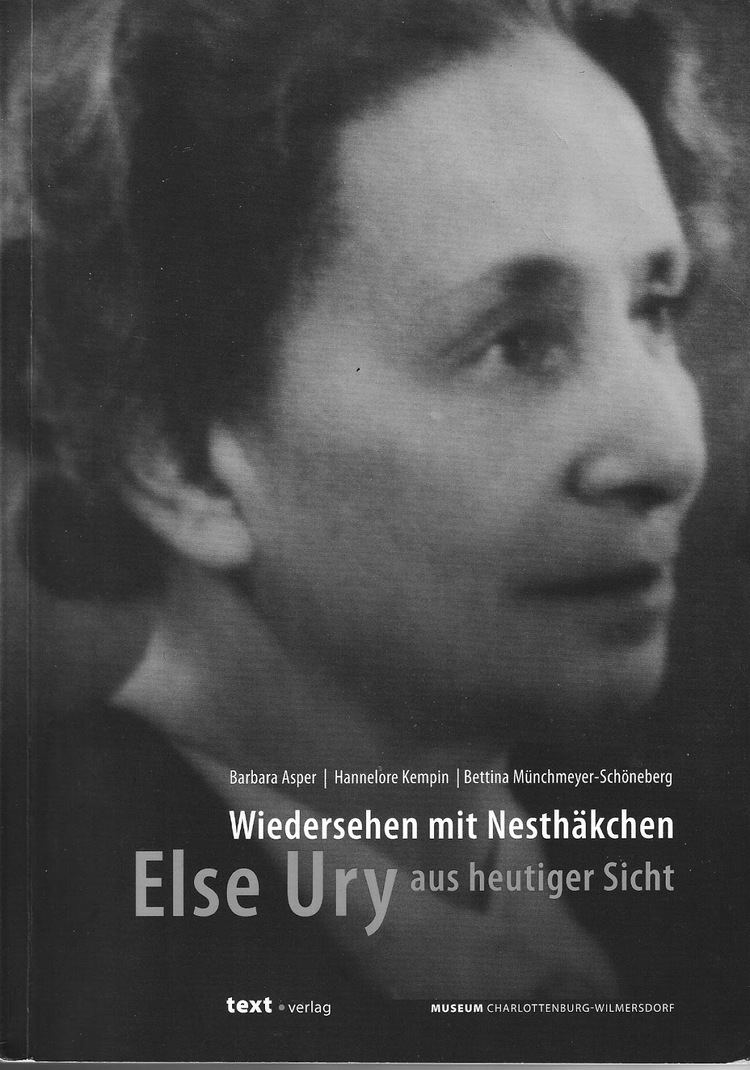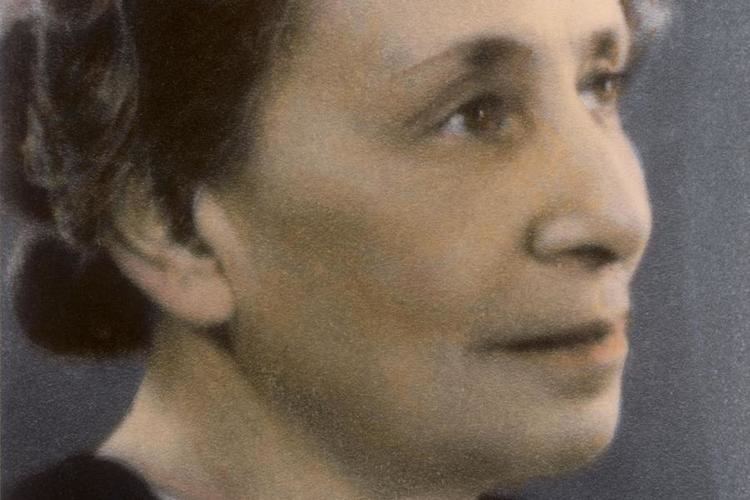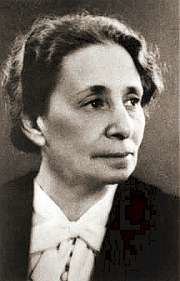Nationality German Name Else Ury | Occupation Novelist Role Writer | |
 | ||
Known for Nesthakchen Series and other books for girls Books Professors Zwillinge | ||
Else Ury: Nesthäkchens erstes Schuljahr, Hörbuch vom Vorleser
Else Ury (November 1, 1877 in Berlin; – January 13, 1943 in the Auschwitz concentration camp) was a German writer and children's book author. Her best-known character is the blonde doctor's daughter Annemarie Braun, whose life from childhood to old age is told in the ten volumes of the highly successful Nesthakchen series. The books, the six-part TV series Nesthakchen (1983), based on the first three volumes, as well as the new DVD edition (2005) caught the attention of millions of readers and viewers. During Ury's lifetime Nesthakchen und der Weltkrieg (Nesthakchen and the World War), the fourth volume, was the most popular. Else Ury was a member of the German Burgertum (middle class). She was pulled between patriotic German citizenship and Jewish cultural heritage. This situation is reflected in her writings, although the Nesthakchen books make no references to Judaism.
Contents
- Else Ury Nesthkchens erstes Schuljahr Hrbuch vom Vorleser
- Nesthkchens 1 Schuljahr Else Ury Kapitel 14 Nesthkchen lernt stricken Vom Vorleser
- Life
- Nesthakchen and the World War
- Nesthakchen series
- Professors Zwillinge series
- Novels
- Short story collections
- References

Nesthäkchens 1. Schuljahr, Else Ury, Kapitel 14. Nesthäkchen lernt stricken. Vom Vorleser.
Life

Else Ury was born in Berlin on 1 November 1877, into a family of Jewish merchants. Her happy childhood and her life with the extended families Ury and Heymann provided the loving environment and inspiration to write her books. The prosperous bourgeois household with cook, governess, housemaid, doorman and impressive furniture which is described by Else Ury in her Nesthakchen series or in Studierte Madel (1906) is a direct reflection of her life in Berlin, particularly after moving to the Kantstrase in Charlottenburg, and later on to Kaiserdamm. While her father Emil (1835–1920) became a successful merchant, her mother Franziska Ury (1847-1940) represented the German Bildungsburgertum (educated middle class). Franziska passed her interest in classic and modern literature, the arts and music on to her children.

Sustained by these concepts of Bildung (education), Else Ury’s siblings started successful middle class careers: Ludwig (1870–1963) became a lawyer, Hans (1873–1937) a medical doctor and Kathe (7 Oct 1881–30 Oct 1944, murdered at Auschwitz), before getting married and starting a family, planned to train as a teacher. Else, however, despite attending the Lyzeum Konigliche Luisenschule, chose not to pursue a profession. She started writing, under a pen name, for the Vossische Zeitung. In 1905 her first book, Was das Sonntagskind Erlauscht (What the Lucky Child Heard), was published by the Globus Verlag. This collection of thirty-eight moral tales promotes pedagogical ideals such as loyalty, honesty and faithfulness. Ury’s subsequent book Goldblondchen (1908) earned her an honorary remark by the influential Jugendschriftenwarte and a further five publications built on this success, until eventually the Nesthakchen series was published between 1918 and 1925 and made her a famous author.
With over thirty-nine books Else Ury was not only one of the most productive female writers of her time, she was also one of the most successful. The combination of an educated mind, humour and compassionate femininity made her books into bestsellers and she was highly celebrated. On her fiftieth birthday, on 1 November 1927, for instance, her publisher, Meidigers Jugendschriftenverlag, honoured her with a large reception at the famous Hotel Adlon.
Her writing made Else Ury rich. Not by an inheritance from her well-to-do father, but from her own earnings, she acquired a vacation home in Krummhubel (Karpacz) in the Riesengebirge. She dubbed the home Haus Nesthakchen. By 1933 Ury had received 250,000 RM royalties for Nesthakchen and another series, Professor’s Twins, an astronomical sum at the nadir of the Great Depression. Millions of her fans bought her books, heard them read on the radio, attended her receptions, and read her newspaper columns. In the Weimar Republic Else Ury had achieved superstar status.
As a Jew during the Holocaust, Ury was barred from publishing, stripped of her possessions, deported to Auschwitz and gassed the day she arrived. Of the 1,000 people on the transport from Berlin, January 13, 1943, 873 people were judged unfit for work, sent straight to the Auschwitz gas chamber and never registered. Hardly anyone knew at the time that the Germans on this day had murdered one of their most famous writers. After the war, Ury’s books were re-published, as if nothing had happened. The Nesthakchen series, issued by Hoch Verlag, appeared in 1952, and was easily edited. The first volume was entitled, "Nesthakchen and her Dolls." The only significant alteration: The fourth volume, "Nesthakchen and the World War" (referring to the First World War), was not reprinted. A short final chapter in the third volume summarized the events of the fourth volume to provide continuity of the series. The remaining nine volumes have been repeatedly reprinted, their total circulation more than seven million copies. When ZDF, the German public-service television broadcaster, filmed the beginning of the series as a 1983 Christmas show, "Nesthakchen" had become an immortal figure in German children's literature. In 2005, the ZDF programs were issued on DVD.
Curiously, the German public hardly knew the fate of the famous author. This changed in 1993, when Marianne Brentzel published her Ury biography with the shocking title, "Nesthakchen arrives in the Concentration Camp." Memorials in Berlin and Karpacz (the location of her vacation home) carry many reminders of Else Ury. On her vacation home, located in Poland today, is emblazoned the title "Dom Nesthakchen (the Nesthakchen House)." After the war the "Jew house" in Berlin-Moabit, Solingerstrase 10, her last Berlin residence before she was deported to Auschwitz, was demolished. An elevated memorial paving stone was laid in front, which reminds passers by of Else Ury and her fellow Holocaust victims. And in her beloved Charlottenburg, where she lived most of her life, an S-Bahn arch is named after her. A cenotaph in Berlin's Weissensee Jewish Cemetery (Judischer Friedhof Weisensee) commemorates her as well.
Nesthakchen and the World War
Else Ury describes in Nesthakchen and the World War the experiences of Annemarie Braun, who is eleven years old when the story begins and thirteen when it ends. Annemarie's father serves as an army doctor in France. Annemarie’s mother is in England with relatives and is not able to return to Germany due to the outbreak of war. Annemarie and her two older brothers, Hans and Klaus, are cared for by a grandmother. Much of Ury’s narrative deals with Annemarie’s experiences with a new classmate, the German-Polish Vera, who does not speak German at the beginning of the story. The popular, headstrong Annmarie coldly excludes Vera from her circle of friends as a foreigner and an alleged spy, making the beautiful, friendly Vera into a class pariah. The resolution of this painful relational aggression builds to a shocking, ringing climax, which has enthralled readers since the book’s publication. Moreover, the ominously unfolding war in the background gives Nesthakchen and the World War poignancy and depth. The book is a timeless commentary on the brutal nature of war.
After 1945 the new publisher removed Nesthakchen and the World War from the Nesthakachen series, because it was on the censorship list of the allied control boards. Ury was, like most German Jews, fiercely patriotic, and her descriptions of the events in and around the First World War were classified as glorifying war. Since 1945 the Nesthakchen series has consisted of only 9 volumes. Steven Lehrer translated Nesthakchen and the World War into English in 2006 and Nesthakchen in the Children's Sanitorium in 2014. Ury also wrote other books and stories, primarily for girls and young women. German women still buy and read Ury's books, almost all of which are in print.
Nesthakchen series
The Nesthakchen series represents a German literary genre, the Backfischroman, a girls' novel that describes maturation and was intended for readers 12 – 16 years old. A Backfisch (“teenage girl”, literally “fish for frying”) is a young girl between fourteen and seventeen years of age. The Backfischroman was in fashion between 1850 and 1950. It dealt overwhelmingly with stereotypes, traditional social images of growing girls absorbing societal norms. The stories ended in marriage, with the heroine becoming a Hausfrau. Among the most successful Backfischroman authors, beside Else Ury, were Magda Trott, Emmy von Rhoden with her Der Trotzkopf and Henny Koch. Ury intended to end the Nesthakchen series with volume 6, Nesthakchen Flies From the Nest. Meidingers Jugendschriften Verlag, her Berlin publisher, was inundated with a flood of letters from Ury's young fans, begging for more Nesthakchen stories. After some hesitation, Ury wrote four more Nesthakchen volumes, and included comments about her initial doubts in an epilogue to volume 7, Nesthakchen and Her Chicks.
